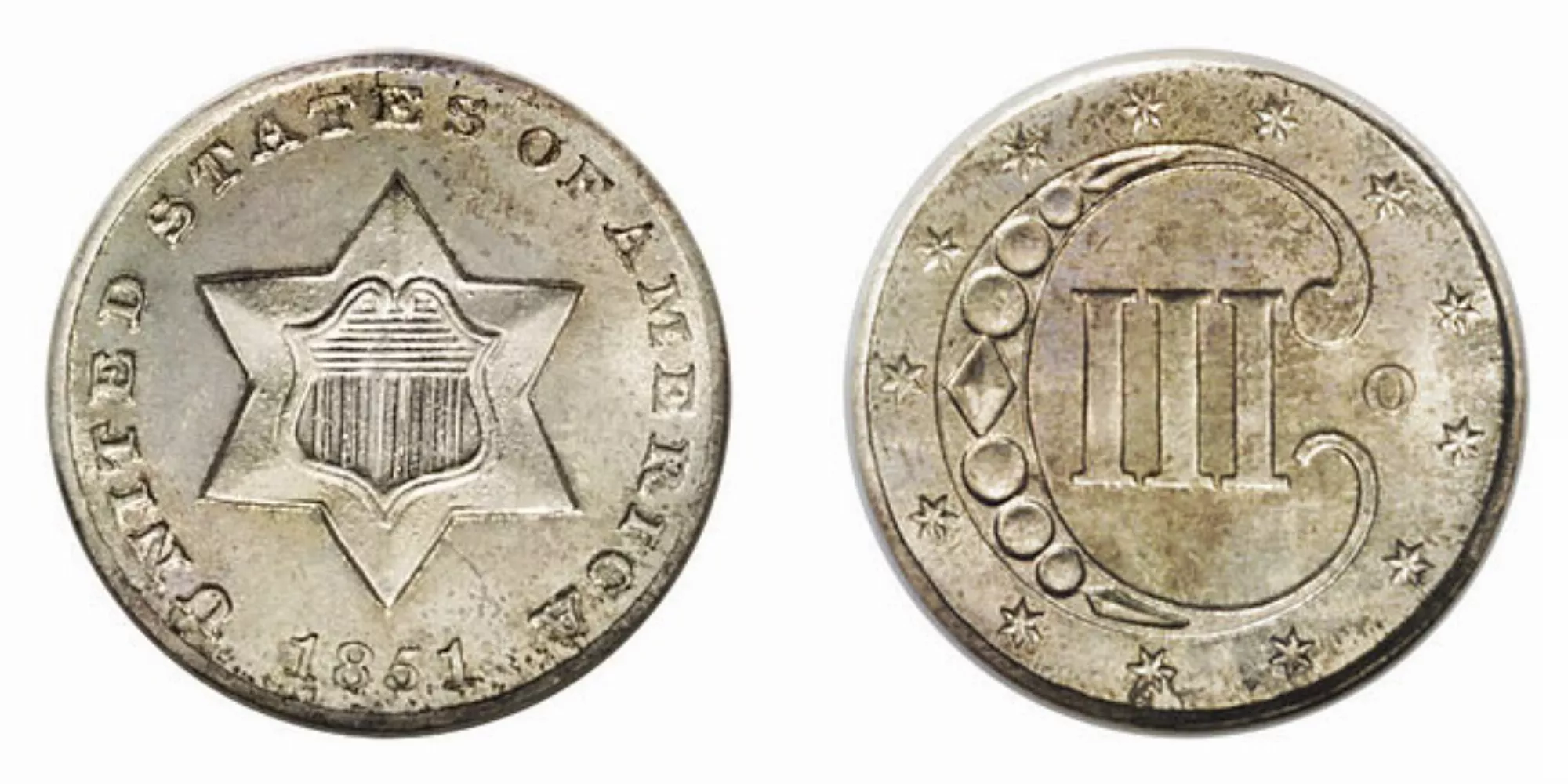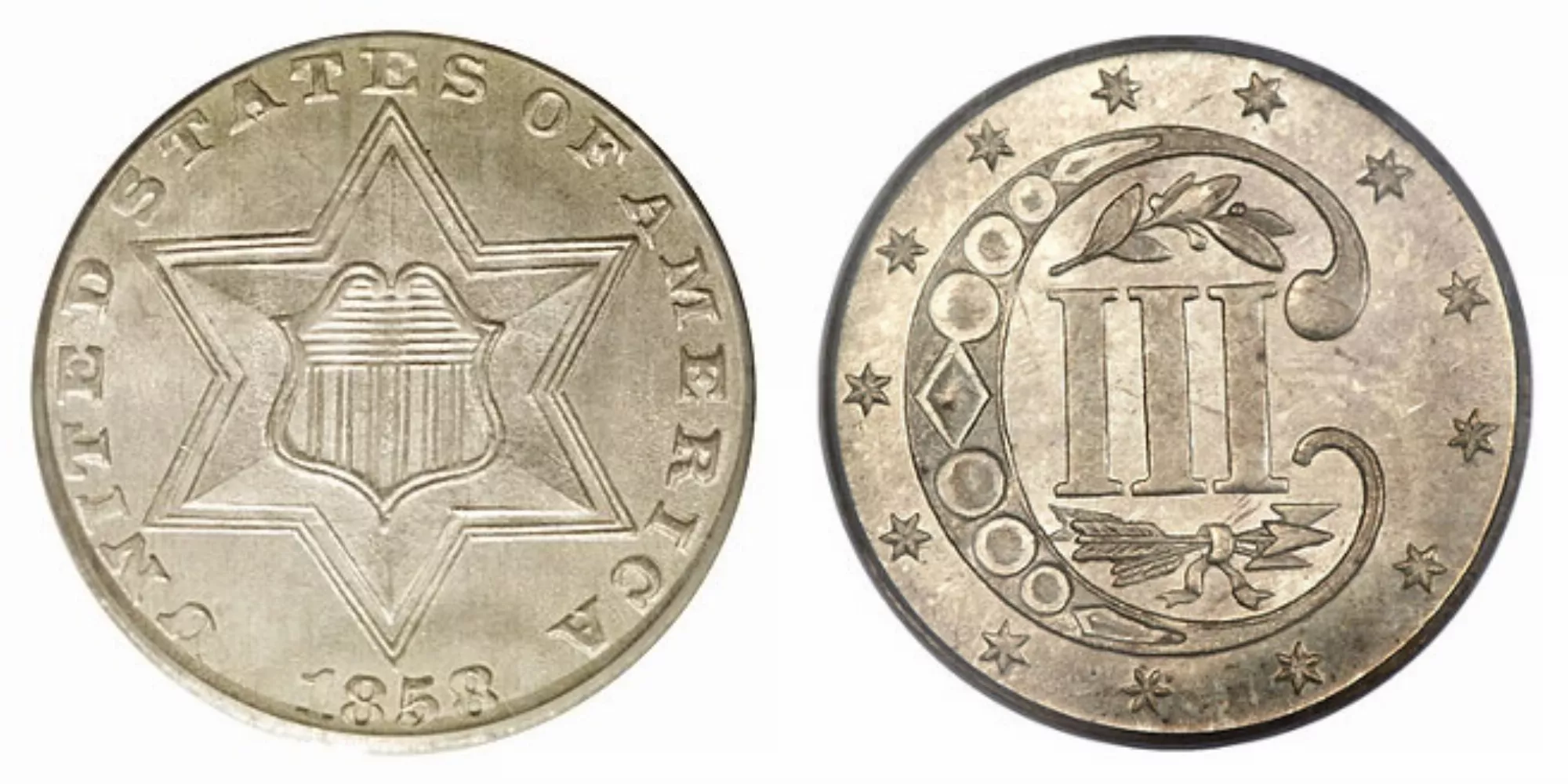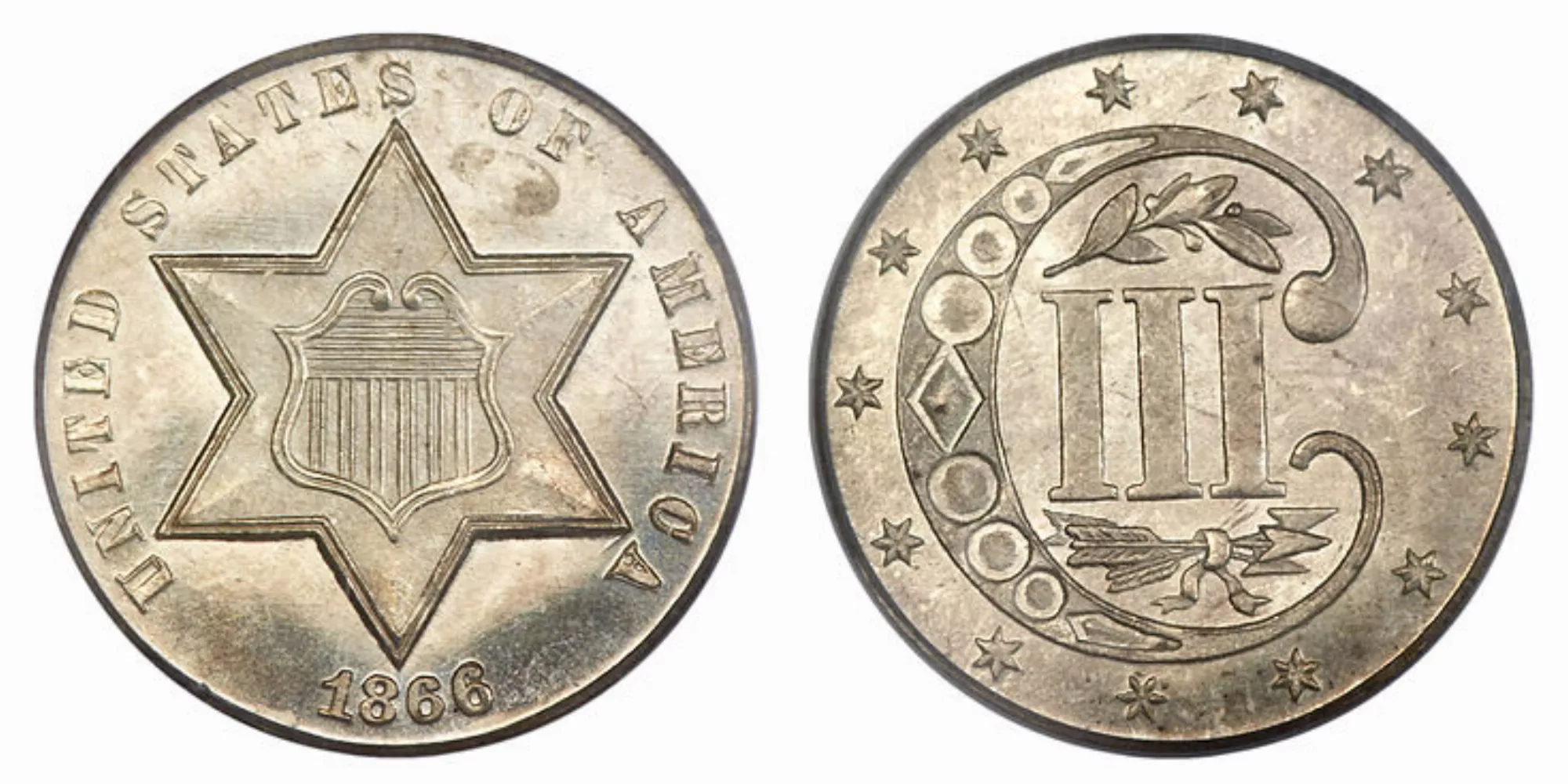Three-cent silver
Type 1 Trime - No Outlines to Star (1851-1853)

| Designer | James B Longacre |
|---|---|
| Diameter | 14 |
| Weight | 0.8 |
| Composition | 75% Silver - 25% Copper |
According to numismatic historian Walter Breen, "the new 3¢ coins were minted in large quantities, went immediately into circulation, and stayed there".[9] Despite mechanical difficulties in striking so small a piece, a total of 5,446,400 were struck at Philadelphia in 1851, and 720,000 at New Orleans—the latter would prove the only mintage of three-cent pieces outside Philadelphia. The coins were shipped directly to post offices for use with stamps. Members of the public who wanted pieces were refused them by mint officials, who advised would-be purchasers to seek them at treasury depository branches.[17]
The small size of the coins, which were dubbed "fish scales", was disliked as they were easily lost.[17] The mint used them to redeem some of the Spanish silver, but the bulk of those foreign coins remained in circulation.[b] A shopper paying for a small purchase with a gold dollar might receive fifteen or so three-cent pieces and the remainder in badly worn fips and other small silver coins. One Philadelphia newspaper reported, derisively, that merchants were reduced to giving ladles full of three-cent pieces in change for a five-dollar banknote.[18]
Silver coins continued to flow out of the U.S. in 1852, and the three-cent silver saw its highest mintage, 18,663,500, all from Philadelphia.[17] The value of these pieces was larger than that of all other silver coins struck by the mints in 1852.[11] The chaotic state of commerce, with no circulating federal coin valued between the three-cent piece and gold dollar, was a source of concern, and mint officials and congressmen corresponded in 1852 concerning a reduction in weight of silver coins such as the half dime and half dollar. Congress at last responded by laws passed on February 21, 1853 and March 3, 1853. These reduced the weight of all silver coins except for the silver dollar. The three-cent piece had its weight reduced from .8 grams to .75, but its fineness increased to .900.[19] Although the other reduced-weight silver coins were given legal tender limits of five dollars, that of the three-cent piece remained at thirty cents. Carothers theorized, "Congress, probably realizing that the 3 cent piece was a misfit at best, preferred to leave it with a discordant legal tender value".[20] Pursuant to these congressional acts, mintage of the type 1 three-cent silver stopped on March 31, 1853.[9] These changes to the silver coinage alleviated the problem of small change, as the new lightweight coins remained in circulation and were not then hoarded.
Type 2 Trime - Three Outlines to Star (1854-1858)

| Designer | James B Longacre |
|---|---|
| Diameter | 14 |
| Weight | 0.75 |
| Composition | 90% Silver - 10% Copper |
The shift to .900 silver for the three-cent silver was intended to help drive the Spanish coins out of circulation. Longacre made changes to both sides of the three-cent silver, engraving a triple line around the star on the obverse and adding an olive branch and bunch of arrows to the reverse. These parallel changes were made to the other silver coins of less than a dollar to distinguish the new, lighter coins from the old. Since it was more urgent to complete work on the modifications to silver coins such as the half dollar and quarter, Longacre left the three-cent piece for last, and did not complete work on the coin until late 1853. The new treasury secretary, James Guthrie, approved the changes on November 10.[23]
Starting with 1854, small quantities of proof coins were struck and apparently distributed in sets with the other silver coins. Beginning in 1858, Mint director James Ross Snowden made the proof sets available to the general public.[23]
The 1853 acts had prohibited the mint from buying silver from the public. Since the silver dollar was heavy relative to its value, little silver was presented for striking into that piece. As the statutes did not permit the public to deposit silver and receive it back in the form of subsidiary silver coins (the three-cent piece through half dollar), this effectively placed the U.S. on the gold standard. Despite the statutes, in 1853 and 1854, Snowden had the mint purchase large quantities of silver bullion at a fixed price, generally above the market rate, and struck it into coin. Since the subsidiary coins were only legal tender to five dollars, and could not be redeemed for gold, this led to a glut of silver coins in commerce. This oversupply, which persisted through 1862,[24] led to lower mintages of silver coins in the mid-1850s, including the three-cent piece.[23] The largest mintage for the type 2 three-cent silver was in 1858, when 1,603,700 were struck for circulation.
Type 3 Trime - Two Outlines to Star (1859-1873)

| Designer | James B Longacre |
|---|---|
| Diameter | 14 |
| Weight | 0.75 |
| Composition | 90% Silver - 10% Copper |
Although there is no archival evidence, Breen theorized that in 1858 Snowden ordered Longacre to make changes to improve striking quality, as most type 2 pieces were weakly struck. The changes include removal of one of the outlines around the star, with smaller and more evenly spaced lettering. Breen suggested that the lettering displays the influence of Assistant Engraver Anthony C. Paquet, who likely assisted Longacre.[26] These changes only affected the obverse; the reverse was not altered.
The economic chaos of the civil war brought the introduction of legal tender notes, backed only by the credit of the government, and by mid-1862, gold and silver coins had vanished from circulation in much of the nation, their place taken by such makeshifts as fractional currency and postage stamps.[27] The three-cent silver remained in circulation longer than the other silver coins, apparently because the public thought it was still made of debased silver, but by the autumn of 1862, it too was hoarded.[28] With little point to issuing coins that would not circulate, mintage of the three-cent silver dropped from 343,000 in 1862 to 21,000 in 1863, a figure that would be exceeded only once (22,000 in 1866) during the rest of the series.[29] In March 1863, Treasury Secretary Salmon P. Chase wrote in a letter that the three-cent silver had entirely vanished from circulation, and suggested that it be issued in aluminum to avoid hoarding.[30]
Congress began the task of restoring federal coins to circulation in 1864 with a two-cent piece in bronze, and by authorizing a three-cent piece in copper-nickel the following year.[30] In 1866, it authorized a five-cent piece in the latter alloy, the nickel, as it has come to be known.[31] With the three-cent silver effectively replaced by base-metal pieces, it did not share in the increased mintage of silver coins that began in 1868.[30] The three-cent silver was struck at the rate of a few thousand per year into the 1870s.[29]
In 1870, Treasury Secretary George Boutwell sent Congress a draft bill to replace the outdated 1837 Mint Act and the bits of legislation passed over the years regarding the mint and coinage. Even in the draft bill, no provision was made for the three-cent silver, though some in Congress wished to retain the coin in anticipation of the resumption of specie payments. After much debate in Congress, President Ulysses S. Grant signed the Coinage Act of 1873 on February 12 of that year. The law abolished the two-cent piece, three-cent silver, half dime, and standard silver dollar (later restored in 1878). Carothers called the abolition of the silver three- and five-cent pieces "a necessity if the 3 cent and 5 cent nickel pieces were to be continued after the revival of silver coinage".[32] Breen deemed the decision to eliminate the silver three-cent piece and the half dime, which might have directly competed with the two copper-nickel coins, a favor to industrialist Joseph Wharton, whose mines produced much of the nickel ore used in coinage.[33] According to numismatist R. W. Julian, the three-cent silver "had played its part well in the U.S. monetary system, but there was no longer any need for it".